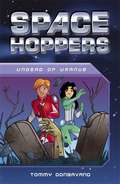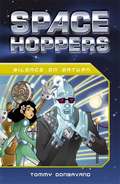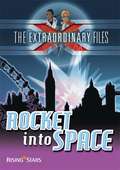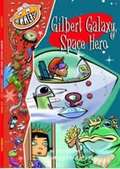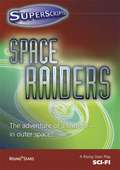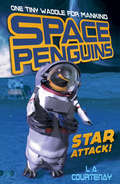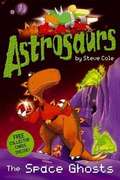Special Collections
Out of this world ....space and all thats out there!
Description: education based books and images to support project based learning fora space theme
- Table View
- List View
Space Hoppers
by Tommy DonbavandSpace Hoppers is a brand new series of hilarious sci-fi fiction from popular author, Tommy Donbavand.
Extraordinary Files
by Paul BlumThis is one in a series of books following Laura and Robert through off-beat, supernatural mysteries that combine an absorbing storyline with text appropriate for struggling readers.
Gigglers, Red
by Christopher StittPrincess Nova popped up on the screen. I need help! she cried. I'm being held prisoner on the planet Floop. Wake up, Tyro, said Gilbert. We're off to save a princess. Based on the success of Sparklers, Gigglers is a new series of chapter books with even funnier storylines and appealing full-colour illustrations. Each book allows your pupils to experience reading success as they gain the skills they need to become confident, eager readers. Each of the 3 levels consist of 8 fast-moving books that are easy to read and easy to understand Research shows that children love funny stories - what keeps them giggling keeps them reading! The Teacher's Guide, for each level, provides comprehensive activity material, copymasters and Guided Reading discussion points for each book
Tardis in Space (UEB uncontracted)
by RnibThis is an image of TV Time Lord Doctor Who's space ship, the Tardis. There is a locator dot shown, which will be at the top left of the page when the image is the correct way up. The picture is surrounded by a dashed line image border. At one time, the TARDIS could change its appearance to match its surroundings but at some point it became stuck in the form of a 1960s blue police telephone box. The rectangular shape of the Tardis is seen from the front and fills most of the central part of the page. Its top is tilted to the left. At the top of the image, on the roof of the box, is a blue light. Down the page from this are two narrow doors, each with a small six-paned window at the top and three panels down the page. The top panel on the door to the left has a small hinged opening. The TARDIS is flying through space and time and is surrounded by small dots representing stars in the distance. The TARDIS is much larger on the inside than the outside: although it looks only big enough to contain one person, it is very spacious inside with room for many people and much sophisticated technology.
Tardis in Space (large print)
by RnibThis is an image of TV Time Lord Doctor Who's space ship, the Tardis. There is a locator dot shown, which will be at the top left of the page when the image is the correct way up. The picture is surrounded by a dashed line image border. At one time, the TARDIS could change its appearance to match its surroundings but at some point it became stuck in the form of a 1960s blue police telephone box. The rectangular shape of the Tardis is seen from the front and fills most of the central part of the page. Its top is tilted to the left. At the top of the image, on the roof of the box, is a blue light. Down the page from this are two narrow doors, each with a small six-paned window at the top and three panels down the page. The top panel on the door to the left has a small hinged opening. The TARDIS is flying through space and time and is surrounded by small dots representing stars in the distance. The TARDIS is much larger on the inside than the outside: although it looks only big enough to contain one person, it is very spacious inside with room for many people and much sophisticated technology.
Tardis in Space (UEB contracted)
by RnibThis is an image of TV Time Lord Doctor Who's space ship, the Tardis. There is a locator dot shown, which will be at the top left of the page when the image is the correct way up. The picture is surrounded by a dashed line image border. At one time, the TARDIS could change its appearance to match its surroundings but at some point it became stuck in the form of a 1960s blue police telephone box. The rectangular shape of the Tardis is seen from the front and fills most of the central part of the page. Its top is tilted to the left. At the top of the image, on the roof of the box, is a blue light. Down the page from this are two narrow doors, each with a small six-paned window at the top and three panels down the page. The top panel on the door to the left has a small hinged opening. The TARDIS is flying through space and time and is surrounded by small dots representing stars in the distance. The TARDIS is much larger on the inside than the outside: although it looks only big enough to contain one person, it is very spacious inside with room for many people and much sophisticated technology.
SuperScripts
by Simon CheshireThe 'SuperScripts' series will help ensure a supportive reading experience for struggling readers. The books have a reading age of six to seven, but are written to appeal to boys and girls from nine to 13 years and over.
Space Penguins
by Lucy CourtenayWhen the crew of the Tunafish pick up a distress signal from a cargo craft, there's snow time to lose. But the Tunafish's daring rescue is canned when the vessel runs into trouble too. What's been luring spacecraft to their doom?
Astrosaurs
by Stephen ColeCaptain Teggs is no ordinary dinosaur - he's an astrosaur! On the incredible spaceship DSS Sauropod, along with his faithful crew, Gipsy, Arx and Iggy, Teggs rights wrongs, fights evil and eats a lot of grass! The astrosaurs are sent to the planet Creepus, where diplodocus miners are searching for space rocks. But they are being disrupted by mysterious, glowing ghosts! What do the spirits want? Teggs searches for the answer in spooky caves, where an old enemy lies in wait ...
SpaceShipOne (UEB Contracted)
byThis page shows an image of SpaceShipOne, designed to be the first non-government funded craft to reach the edge of space at just over one hundred kilometres. It was launched from a purpose-built aircraft, White Knight. There is a locator dot shown, which will be at the top left of the page when the image is the right way up. At the top centre of the page is the nose cone of the craft with many small round windows shown in a heavy texture. Down the page is the body of the plane and down again is the nozzle of the engine and the hot gases being expelled towards the bottom of the page. To the left and right of the body are the two wings. They are hinged so that their configuration can be changed for the climbing, gliding, and re-entry stages of flight.
SpaceShipOne (Large Print)
byThis page shows an image of SpaceShipOne, designed to be the first non-government funded craft to reach the edge of space at just over one hundred kilometres. It was launched from a purpose-built aircraft, White Knight. There is a locator dot shown, which will be at the top left of the page when the image is the right way up. At the top centre of the page is the nose cone of the craft with many small round windows shown in a heavy texture. Down the page is the body of the plane and down again is the nozzle of the engine and the hot gases being expelled towards the bottom of the page. To the left and right of the body are the two wings. They are hinged so that their configuration can be changed for the climbing, gliding, and re-entry stages of flight.
International Space Station (UEB Contracted)
byThis is an image of the ISS, a very large man-made satellite orbiting the Earth at a height of 350 kilometres. There is a locator dot shown, which will be at the top left of the page when the image is the right way up. The station is used mainly for scientific research and although originally built by Russia and America, it is now manned by representatives of fourteen nations. In the centre of the page are the modules used for living and scientific research. These are attached one to another and reach the top of the page with the topmost one used as a dock for the Space Shuttle. Two rectangular solar panels extend out to the left and right of the modules. Down the page from these is the main truss running across the page. This supports two much larger panels on the far left and right of the page. Just to the left of centre, on the main truss, there is the mobile servicing system, which runs on rails, has two robot arms and is used for various construction and servicing tasks. To give an idea of the size of the structure, a scale image of a person in a space suit (approximately 6 mm high) is shown at the top centre of the page, just to the left of the research modules. The space station is constantly being changed and added to, so this diagram can only give an approximate impression of its layout.
International Space Station (UEB Uncontracted)
byThis is an image of the ISS, a very large man-made satellite orbiting the Earth at a height of 350 kilometres. There is a locator dot shown, which will be at the top left of the page when the image is the right way up. The station is used mainly for scientific research and although originally built by Russia and America, it is now manned by representatives of fourteen nations. In the centre of the page are the modules used for living and scientific research. These are attached one to another and reach the top of the page with the topmost one used as a dock for the Space Shuttle. Two rectangular solar panels extend out to the left and right of the modules. Down the page from these is the main truss running across the page. This supports two much larger panels on the far left and right of the page. Just to the left of centre, on the main truss, there is the mobile servicing system, which runs on rails, has two robot arms and is used for various construction and servicing tasks. To give an idea of the size of the structure, a scale image of a person in a space suit (approximately 6 mm high) is shown at the top centre of the page, just to the left of the research modules. The space station is constantly being changed and added to, so this diagram can only give an approximate impression of its layout.
International Space Station (Large Print)
byThis is an image of the ISS, a very large man-made satellite orbiting the Earth at a height of 350 kilometres. There is a locator dot shown, which will be at the top left of the page when the image is the right way up. The station is used mainly for scientific research and although originally built by Russia and America, it is now manned by representatives of fourteen nations. In the centre of the page are the modules used for living and scientific research. These are attached one to another and reach the top of the page with the topmost one used as a dock for the Space Shuttle. Two rectangular solar panels extend out to the left and right of the modules. Down the page from these is the main truss running across the page. This supports two much larger panels on the far left and right of the page. Just to the left of centre, on the main truss, there is the mobile servicing system, which runs on rails, has two robot arms and is used for various construction and servicing tasks. To give an idea of the size of the structure, a scale image of a person in a space suit (approximately 6 mm high) is shown at the top centre of the page, just to the left of the research modules. The space station is constantly being changed and added to, so this diagram can only give an approximate impression of its layout.
SpaceShipOne (UEB Uncontracted)
byThis page shows an image of SpaceShipOne, designed to be the first non-government funded craft to reach the edge of space at just over one hundred kilometres. It was launched from a purpose-built aircraft, White Knight. There is a locator dot shown, which will be at the top left of the page when the image is the right way up. At the top centre of the page is the nose cone of the craft with many small round windows shown in a heavy texture. Down the page is the body of the plane and down again is the nozzle of the engine and the hot gases being expelled towards the bottom of the page. To the left and right of the body are the two wings. They are hinged so that their configuration can be changed for the climbing, gliding, and re-entry stages of flight.
Astrosaurs
by Stephen ColeCaptain Teggs is no ordinary dinosaur - he's an astrosaur! On the incredible spaceship DSS Sauropod, along with his faithful crew, Gipsy, Arx and Iggy, Teggs rights wrongs, fights evil and eats a lot of grass! The astrosaurs are sent to the planet Creepus, where diplodocus miners are searching for space rocks. But they are being disrupted by mysterious, glowing ghosts! What do the spirits want? Teggs searches for the answer in spooky caves, where an old enemy lies in wait ...
US Space Shuttle (tactile)
by Adrian FarnsworthOn this page there are three images of the now-retired US space shuttle used to carry people and supplies. Image 1 is of the shuttle seen from the top, facing left at the top left of the page. Image 2 is of the shuttle seen from the side, facing left at the bottom left of the page. Image 3 is of the shuttle seen from the front at the bottom right of the page.
Space Shuttle (UEB Uncontracted)
byThis is a diagram of an American space shuttle, designed to carry large loads in an orbital path around the circumference of the Earth. There is a locator dot shown, which will be at the top left of the page when the image is the right way up. The shuttle is shown in two views: a plan view (seen from above) and a side view. The shuttle is carried into the upper atmosphere of the earth by SRBs (solid rocket boosters) and then continues under the power of its own engines. The plan view is in the top left part of the page. The nose cone of the shuttle is at the far left. Directly right of this is the cockpit window, the main body of the craft with the payload doors, the engine covers, the rudder, and the engines. The swept-back wings of the shuttle extend up and down the page from the main body. To the far right of the plan view the expelled gasses that push the craft through space can be found. The side view of the shuttle is in the bottom right of the page. At the left of the image is the nose cone with a landing wheel just down the page. Moving right is the main body of the craft with the payload doors at the top and the wings and rear landing wheel down the page. Further to the right two of the four engines are visible with expelled gasses at the far right. Slightly up the page is the rudder.
Space Shuttle (UEB Contracted)
byThis is a diagram of an American space shuttle, designed to carry large loads in an orbital path around the circumference of the Earth. There is a locator dot shown, which will be at the top left of the page when the image is the right way up. The shuttle is shown in two views: a plan view (seen from above) and a side view. The shuttle is carried into the upper atmosphere of the earth by SRBs (solid rocket boosters) and then continues under the power of its own engines. The plan view is in the top left part of the page. The nose cone of the shuttle is at the far left. Directly right of this is the cockpit window, the main body of the craft with the payload doors, the engine covers, the rudder, and the engines. The swept-back wings of the shuttle extend up and down the page from the main body. To the far right of the plan view the expelled gasses that push the craft through space can be found. The side view of the shuttle is in the bottom right of the page. At the left of the image is the nose cone with a landing wheel just down the page. Moving right is the main body of the craft with the payload doors at the top and the wings and rear landing wheel down the page. Further to the right two of the four engines are visible with expelled gasses at the far right. Slightly up the page is the rudder.
Space Shuttle (Large Print)
byThis is a diagram of an American space shuttle, designed to carry large loads in an orbital path around the circumference of the Earth. There is a locator dot shown, which will be at the top left of the page when the image is the right way up. The shuttle is shown in two views: a plan view (seen from above) and a side view. The shuttle is carried into the upper atmosphere of the earth by SRBs (solid rocket boosters) and then continues under the power of its own engines. The plan view is in the top left part of the page. The nose cone of the shuttle is at the far left. Directly right of this is the cockpit window, the main body of the craft with the payload doors, the engine covers, the rudder, and the engines. The swept-back wings of the shuttle extend up and down the page from the main body. To the far right of the plan view the expelled gasses that push the craft through space can be found. The side view of the shuttle is in the bottom right of the page. At the left of the image is the nose cone with a landing wheel just down the page. Moving right is the main body of the craft with the payload doors at the top and the wings and rear landing wheel down the page. Further to the right two of the four engines are visible with expelled gasses at the far right. Slightly up the page is the rudder.
